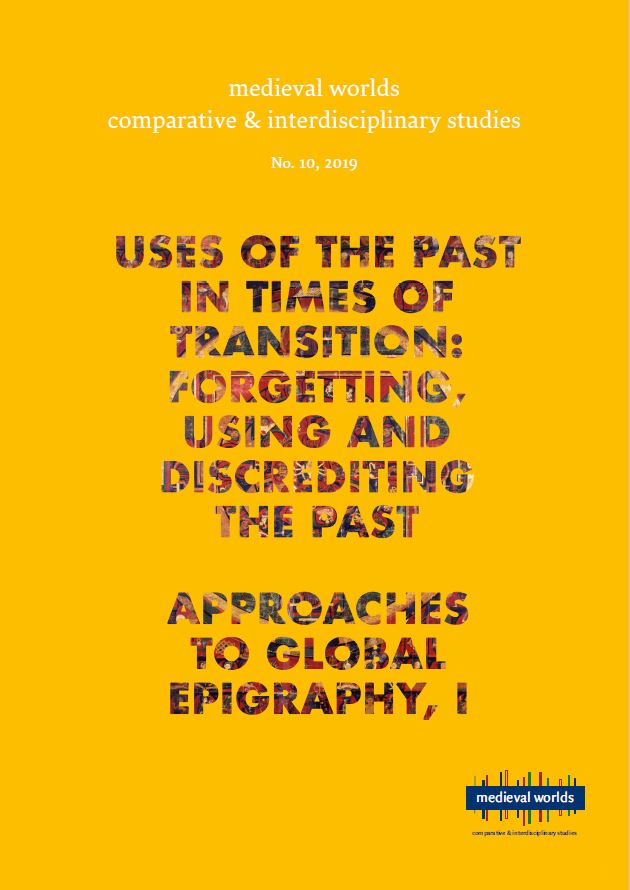Christian Jahoda
S. 199 - 251
doi:
10.1553/medievalworlds_no10_2019s199
Verlag der Österreichischen Akademie der Wissenschaften
doi:
10.1553/medievalworlds_no10_2019s199
Abstract:
The area of the 10th-11th-century West Tibetan kingdom and its successor kingdoms Purang, Guge and Ladakh is today mainly divided between China and India, with a small part belonging to Nepal. Tibetan inscriptions constitute an important part of the extensive Buddhist heritage and vital cultural traditions in areas all over historical Western Tibet. This paper seeks to present an overview on these inscriptions in key areas of historical Western Tibet, such as Purang and Guge (including Spiti and Upper Kinnaur), based on selected examples, all of which were documented in situ during the past two decades by taking into account their various contexts. In the first part, after a brief introduction on the research history, the geographical-historical setting and spatial and functional contexts of inscriptions are discussed, which are mainly characterized by Tibetan Buddhism. Then, the dominating emic concept of religious purpose (merit) and Tibetan terminology related to inscriptions, technical and material realities are briefly given attention before highlighting relevant administrative and ritual practices as well as visual aspects. Finally, structured mainly on the material support on which inscriptions are found (correlating to some degree with the chronological distribution), a number of inscriptions on stone, mineral building materials, metal, clay and cloth are analysed and also presented through illustrations, partly also in transliteration and in translation, in order to demonstrate the various different types of inscriptions, their content, materiality, functions and contexts.
historical Western Tibet; Tibetan Buddhism; inscriptions: Tibetan terminology; merit; material support; inscriptions on stone; inscriptions on mineral building materials; inscriptions on cloth; inscriptions on clay.
Published Online:
2019/11/28 21:33:01
Object Identifier:
0xc1aa5576 0x003b0da6
Rights:All rights reserved.For questions regarding copyright and copies please contact us by email.
medieval worlds provides a forum for comparative, interdisciplinary and transcultural studies of the Middle Ages. Its aim is to overcome disciplinary boundaries, regional limits and national research traditions in Medieval Studies, to open up new spaces for discussion, and to help developing global perspectives. We focus on the period from c. 400 to 1500 CE but do not stick to rigid periodization.
medieval worlds is open to submissions of broadly comparative studies and matters of global interest, whether in single articles, companion papers, smaller clusters, or special issues on a subject of global/comparative history. We particularly invite studies of wide-ranging connectivity or comparison between different world regions.
Apart from research articles, medieval worlds publishes ongoing debates and project and conference reports on comparative medieval research.
Table of Contents
Uses of the Past in Times of Transition:
Forgetting, Using and Discrediting the Past
Introduction. Making the Past in Late and Post-Carolingian Historiography
Maximilian Diesenberger
The Church as a Governance Actor in a Period of Post-Imperial Transition:
Delegation of Fiscal Rights and Legal Change in 10th-century Churraetia
Stefan Esders
Understanding the Church’s Past:
Usuard’s Martyrology in Tenth-and Eleventh-century England
Sarah Hamilton
Creating an »Orthodox« Past:
Georgian Hagiography and the Construction of a Denominational Identity
Emma Loosley Leeming
Using the Carolingian Past in a Society of Transformation:
The Case of Early Medieval Septimania/Catalonia in the Long Tenth Century (900-1050)
Matthias M. Tischler
Uses of the Past in Early Medieval Iberia (Eighth-Tenth Centuries)
Jorge Elices Ocón and Eduardo Manzano Moreno
Royal Marriage, Frankish History and Dynastic Crisis in Regino of Prüm’s Chronicle
Eric J. Goldberg and Simon MacLean
Negotiating the Roman Past in Later Tenth-century Armenia
Tim Greenwood
Aitire, 人質, тали, όμηρος, رهن , obses: Hostages, Political Instability,
and the Writing of History c. 900-c. 1050 CE
Alice Hicklin
Approaches to Global Epigraphy, I
Global Epigraphy: The Scholarship on Inscriptions of Eurasia
from Antiquity to the Early Modern Period
Andreas Rhoby, Veronika Scheibelreiter-Gail and Andreas Zajic
Archaeological Contexts of Inscriptions in the Private Sphere:
The Mosaic Inscriptions of a villa rustica in Skala/Cephalonia
Elisabeth Rathmayr and Veronika Scheibelreiter-Gail
Inscriptions in Areas of Historical Western Tibet (mNga’ ris skor gsum) in their Contexts:
A Brief Overview with Selected Examples
Christian Jahoda
Byzantine Connections
History and Exegesis in the Itinerarium of Bernard the Monk (c. 867)
Daniel Reynolds




 Home
Home Print
Print
 References
References
 Share
Share
